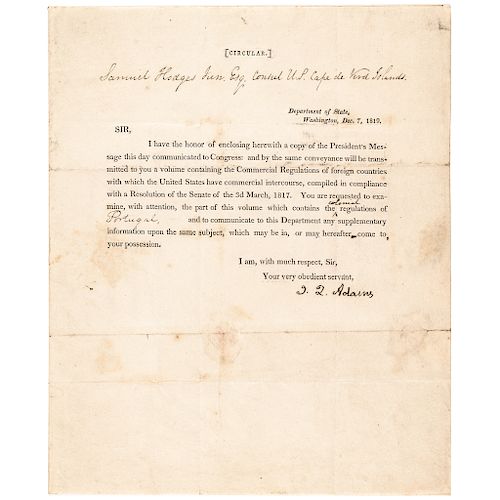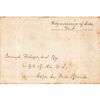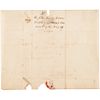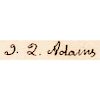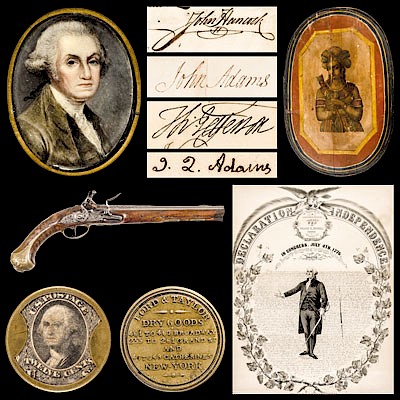1819 JOHN QUINCY ADAMS Signed US Department of State Circular Letter on Trade
Lot 2
Estimate:
$1,000 - $1,200
Absentee vs Live bid
Two ways to bid:
- Leave a max absentee bid and the platform will bid on your behalf up to your maximum bid during the live auction.
- Bid live during the auction and your bids will be submitted real-time to the auctioneer.
Bid Increments
| Price | Bid Increment |
|---|---|
| $0 | $10 |
| $200 | $20 |
| $300 | $25 |
| $500 | $50 |
| $1,000 | $100 |
| $2,000 | $200 |
| $3,000 | $250 |
| $5,000 | $500 |
| $10,000 | $1,000 |
| $20,000 | $2,000 |
| $30,000 | $2,500 |
| $50,000 | $5,000 |
| $100,000 | $10,000 |
| $200,000 | $20,000 |
| $300,000 | $25,000 |
| $500,000 | $50,000 |
About Auction
By Early American History Auctions
Jun 1, 2019
Set Reminder
2019-06-01 12:00:00
2019-06-01 12:00:00
America/New_York
Bidsquare
Bidsquare : Historic Autographs, Colonial Currency, Political Americana & Revolutionary War Era
https://www.bidsquare.com/auctions/early-american-history-auctions/historic-autographs-colonial-currency-political-americana-revolutionary-war-era-4152
Historic Autographs, Coins, Currency, Political, Americana, Historic Weaponry and Guns, John Adams, Thomas Jefferson, Early American History Auctions auctions@earlyamerican.com
Historic Autographs, Coins, Currency, Political, Americana, Historic Weaponry and Guns, John Adams, Thomas Jefferson, Early American History Auctions auctions@earlyamerican.com
- Lot Description
Autographs
1819 Secretary of State John Quincy Adams Signed Oversees U.S. Commercial Regulations In Official Documentation
JOHN QUINCY ADAMS (1767-1848). 6th President of the United States (1825-1829); Negotiated with the United Kingdom over America's northern border with Canada; with Spain the annexation of Florida; one of the earliest Anti-Slavery Leaders; authored the "Monroe Doctrine" thus one of the greatest Diplomats and Secretaries of State in American history.
December 7, 1819-Dated, Partially-Printed Official United States Printed Department of State Circular Letter with Passenger Manifest Document Signed, "J. Q. Adams" as Secretary of State, 4 pages (Front is Signed), measures 8" x 9.5", from Washington, Choice Very Fine. Written to Samuel Hodges Jun. Esq. Consul U.S. Cape Verde Islands. This Document is an official correspondence enclosing other information on the particular U.S. Trade Regulations, approved by Congress, being enclosed. It reads, in part:
" - SIR, - I have the honor of enclosing herewith a copy of the President's Message this day communicated to Congress: ... Commercial Regulations of foreign countries with which the United States have commercial intercourse, complied in compliance with a Resolution of the Senate of the 3d March, 1817..."
Two adjoining Internal leaves on this original Document provide for a Docket and Integral Address Panel completed in J. Q. Adams' hand noted as, "Department of State U. S." addressed to Samuel Hodges, Consul of the U. S." with red sealing wax remaining though broken when opened. Signed boldly on the face page at the lower right, "J. Q. Adams". Scarce.
John Qunicy Adams served as the sixth President of the United States from March 4, 1825, to March 4, 1829. He took the oath of office on a book of laws, instead of the more traditional Bible, to preserve the separation of church and state.
The Adams administration's record was thin; he made many proposals to Congress but it passed few of them; there were some minor foreign policy achievements. Adams proposed an elaborate program of internal improvements (roads, ports and canals), a national university, and federal support for the arts and sciences.
He favored a high tariff to encourage the building of factories, and restricted land sales to slow the movement west. Opposition from the states' rights faction of a hostile congress killed many of his proposals. He also reduced the national debt from $16 million to $5 million, the remainder of which was paid off by his successor.
- Shipping Info
-
Early American provides in-house worldwide shipping. Please contact us directly if you have questions about your specific shipping requirements.
-
- Buyer's Premium



 EUR
EUR CAD
CAD AUD
AUD GBP
GBP MXN
MXN HKD
HKD CNY
CNY MYR
MYR SEK
SEK SGD
SGD CHF
CHF THB
THB